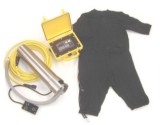Diver Heating
 Divers in the Canadian Navy must dive in some of the coldest water on earth.
Although the work they perform may not be that long in duration, the time spent
during the decompression phase of the dive can be several hours in water
as cold as 0C.
Divers in the Canadian Navy must dive in some of the coldest water on earth.
Although the work they perform may not be that long in duration, the time spent
during the decompression phase of the dive can be several hours in water
as cold as 0C.
Stream Function is currently working with DRDC to develop a diver heating system for the Canadian Navy. DRDC successfully completed several weeks of dives in January and February of this year without any equipment failures. Further testing is scheduled for next winter.
Description
The purpose of the diver heating system is to provide active heating for body warming of cold water divers. This is achieved using a closed-circuit, warm water heating system that has a heat exchanger integrated into the dry suit of the diver. The heating unit (DHU) operates underwater near or on the diver. The microprocessor in the DHU monitors and controls the water temperature. The conditioned water is delivered to the diver through a short umbilical hose, which is connected to the dry suit penetrator. The diver wears tubed clothing close to the skin that acts as a large heat exchanger between the diver and the warm water. The water then returns to the DHU through the umbilical hose where it is reheated. The DHU has an underwater control panel attached. The diver can control all functions of the DHU using this panel including adjusting the desired set point of the water temperature.
The electrical power is supplied from the surface through a power cable. The surface power is monitored by the microprocessor in the MCU. The MCU is responsible for main power switching and GFI protection. The MCU provides the surface team with visual feedback as to the operation of the DHU, the condition of the battery power source and the option to override the GFI.
History
The current diver heating system has a long development history. The initial prototype diver heating system development was contracted to Delta Temax Inc.(DTI) in 1996. The initial system showed significant potential and the development of a more manufacturable version called the Advanced Demonstration Model (ADM) began shortly afterwards.
Dr. Corriveau was involved in some of the final stages of the ADM. Specifically, he was responsible for the firmware that controls the DHU and MCU, as well as the selection and placement of sensors. He had input into the design and development of the electronics, pump motor selection and other aspects of the thermal/hydraulic design. Finally, Dr. Corriveau designed the thermal tests to be used to certify each unit at DTI.
In 2001, Med-Eng Systems Inc purchased DTI. Approximately a year or so later, it became apparent that the Diver Heating System was not a good fit to Med-Eng's corporate goals. Because of Dr. Corriveau's previous involvement, Stream Function was a logical choice for continuing the development. At the time that Stream Function took over the development work of the diver heating system, the units had several outstanding reliability issues.
In 2002, Stream Function provided a complete overhaul on all ADM systems currently in use at DRDC. A FMEA was conducted to identify the specific areas in the design or construction that required attention. The overhaul included refurbishing the pumps, calibration of sensors, as well as upgrading the electronics.
Further dives are required under controlled conditions before sea trials can begin. It is anticipated that the controlled dives can be completed this coming winter. Sea trials will be followed by the development of the production prototypes.

